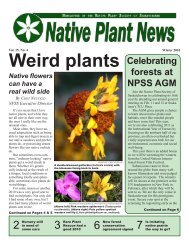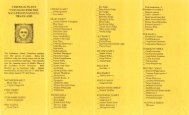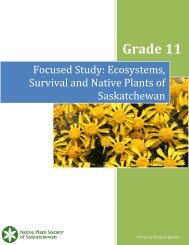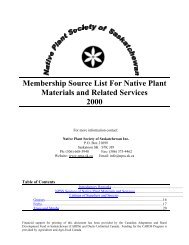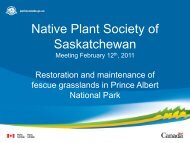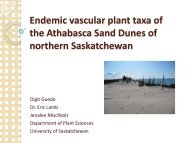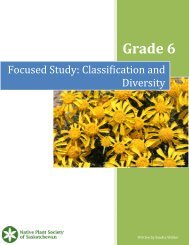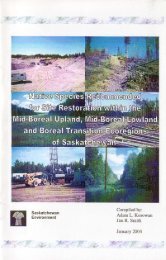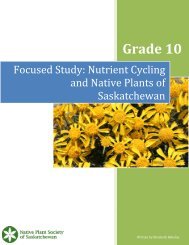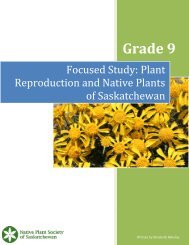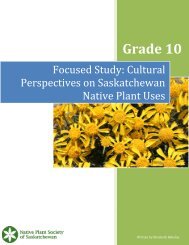Grade 2 Lesson Plan - Native Plant Society of Saskatchewan
Grade 2 Lesson Plan - Native Plant Society of Saskatchewan
Grade 2 Lesson Plan - Native Plant Society of Saskatchewan
- No tags were found...
You also want an ePaper? Increase the reach of your titles
YUMPU automatically turns print PDFs into web optimized ePapers that Google loves.
<strong>Grade</strong> 2Focused Study: Stewardship andSustainabilityWritten by Sandra Walker
The <strong>Native</strong> <strong>Plan</strong>t <strong>Society</strong> <strong>of</strong> <strong>Saskatchewan</strong> is a strong advocate <strong>of</strong> natureeducation.In addition to this lesson plan, we also support schools by:- providing free printed resources.- leading field tours.- delivering outdoor and classroom presentations.- hosting opportunities to "ask an expert", where students can interact with apr<strong>of</strong>essional biologist or related occupation though in person events or Skype. In somecases, we can arrange for French speaking experts.We also support the establishment <strong>of</strong> native plant learning gardens on school groundsby <strong>of</strong>fering free native seeds, printed resources, personal visits, presentations andexpert advice to help with all stages <strong>of</strong> the process. The gardens can be as small as asquare meter.All <strong>of</strong> what we do is always free for participating schools.Does any <strong>of</strong> this sound like something you'd want? If so, please call us at (306) 668-3940 or e-mail us at info@npss.sk.caFree Electronic Resources on the <strong>Native</strong> <strong>Plan</strong>t <strong>Society</strong> <strong>of</strong> <strong>Saskatchewan</strong> Website(www.npss.sk.ca)A Guide to Small Prairie Restoration - How to Grow Your Own Patch <strong>of</strong> <strong>Native</strong> Prairie<strong>Saskatchewan</strong>'s <strong>Native</strong> Prairie: Taking Stock <strong>of</strong> a Vanishing Ecosystem and DwindlingResource (Also available in print)On the Prairie - A webpage on our site with a "Build a Prairie" game, field guide to prairieplants and animals, curriculum goodies like a English-Dakota language guide, and virtualreality panoramas <strong>of</strong> prairie placesThe Watershed GameFree Printed Materials Available Through the <strong>Native</strong> <strong>Plan</strong>t <strong>Society</strong> <strong>of</strong> <strong>Saskatchewan</strong>:<strong>Native</strong> <strong>Plan</strong>ts, Water and Us! (Booklet)<strong>Native</strong> <strong>Plan</strong>ts, Water and Us! (Poster)<strong>Native</strong> <strong>Plan</strong>t Communities <strong>of</strong> <strong>Saskatchewan</strong> (Poster)<strong>Native</strong> <strong>Plan</strong>t Communities <strong>of</strong> <strong>Saskatchewan</strong> (Activity Sheet)
FOCUSED STUDY: STEWARDSHIP AND SUSTAINABILITYGRADE 2OVERVIEW AND PURPOSEThe scope <strong>of</strong> this study guide includes investigating concepts <strong>of</strong> stewardship and sustainabilityand the impacts <strong>of</strong> human activities on natural ecosystems, habitats and native plantcommunities. This guided study is intended to target applicable and selected outcomes andindicators in several areas <strong>of</strong> the curriculum.OUTCOMES AND INDICATORSPhysical Science: Air and Water in the Environment (AW)AW2.2 Assess the importance <strong>of</strong> air and water for the health and survival <strong>of</strong> living things,including self, and the environment. [CP, DM]Students will be encouraged to develop responsibility in the application <strong>of</strong> science andtechnology in relation to society and the natural environment.Understand the Nature <strong>of</strong> Science and STSE Interrelationships - Students will develop anunderstanding <strong>of</strong> the nature <strong>of</strong> science and technology, their interrelationships, and their socialand environmental contexts, including interrelationships between the natural and constructedworld.Pose questions about the growth and development <strong>of</strong> familiar animals.STEWARDSHIPStewardship can be defined as taking good care <strong>of</strong> something important for oneself and otherliving things for now and the future. Stewardship includes forward looking and responsibleplanning and follow through (actions) with respect to resources such as air, water, soil, plants,animals, food and the ecosystems on which all life depends, so that the needs <strong>of</strong> people andother living things are met in a sustainable way. Sustainability means that needs should not justbe met just for today, but for future generations as well.The natural world provides us with all the essential things we require for life. Some <strong>of</strong> thesethings are obvious, and others not so obvious. For instance, trees in forests, which cover much<strong>of</strong> the northern part <strong>of</strong> <strong>Saskatchewan</strong>, provide us with wood for building materials and paper forbooks. Forests also provide other less obvious things for us and other living things, by helpingclean the air we breathe and the water we drink. Forests also provide living space (habitat) forwildlife. Similar to forests, the parklands in the central portion <strong>of</strong> <strong>Saskatchewan</strong> (made up <strong>of</strong>tree and shrub areas interspersed with open areas and grasslands), and prairies, which occupythe southern parts <strong>of</strong> <strong>Saskatchewan</strong>, also provide us and other living things with an abundance<strong>of</strong> resources. These resources include rich soil on which to grow crops which feed us and manypeople beyond <strong>Saskatchewan</strong>. Natural areas that remain in the central and southern parts <strong>of</strong><strong>Saskatchewan</strong>, such as natural grasslands, provide nutritious grazing areas for cattle, whichagain feed us and many others beyond <strong>Saskatchewan</strong>. These natural areas also provideimportant habitat for wildlife and plants. <strong>Plan</strong>ts in these areas also help clean the air webreathe and the water we drink. Bogs, lakes, wetlands, creeks and rivers that flow through
these areas also are important in sustaining the plants, wildlife and ourselves by providing andcleaning water that sustains all life.How are forests, parklands and grasslands being used? Are we being good stewards <strong>of</strong> theseareas? What are the impacts <strong>of</strong> human activity in these areas? These are important questionsand there are no quick and easy answers. As a society, we are certainly developing theresources <strong>of</strong>fered by forests, parklands and grasslands, but are the ways we are going about itsustainable? Are there better ways go about making a living in these areas? Is it important tobe careful when developing a resource? To help students understand stewardship,sustainability and the surrounding issues, stewardship <strong>of</strong> two ecosystems will be examined,including forests and native prairie. Understanding how altering environments may havesignificant effects at many levels, such as on plants, wildlife and water quality, are key concepts.Students should come away with an understanding that as people, we have come to alterlandscapes in big ways that can affect natural environments and that we need to take the role <strong>of</strong>being stewards seriously.FORESTSThe northern parts <strong>of</strong> <strong>Saskatchewan</strong> have large forests, and are divided into the northern andsouthern boreal forests. The northern boreal forest is made up mostly <strong>of</strong> coniferous species,which are cone bearing seed plants. The most common trees in this area are s<strong>of</strong>twood trees,including black spruce and jack pine, which are needle leaf trees. These types <strong>of</strong> trees keep theirleaves for several years. Other trees that are found in this area include hardwood trees such aswhite birch and trembling aspen, which are deciduous trees that lose their leaves every fall.Much <strong>of</strong> this area lies over the Precambrian or Canadian Shield, which is a layer <strong>of</strong> hard rockwhich has very thin soils and many rocky outcrops. These poor soil conditions, coupled with thecolder climate, limit the growth and size <strong>of</strong> trees and the diversity <strong>of</strong> plants.The southern boreal forest has richer soils and longer growing seasons and as a result has morekinds <strong>of</strong> plants and is more productive. This is shown by the large areas <strong>of</strong> very tall trees whichcan reach heights <strong>of</strong> 25 to 30 m. The forests in this area, like many others, are constantlychanging. Historically, fires have changed the area in a sequence. After a fire, fast growing butshorter lived hardwood trees, such as trembling aspen, would take over. Slower growing butlonger lived s<strong>of</strong>twoods, such as white or black spruce or jack pine, would gradually form anunderstory and eventually take over large areas as the short lived s<strong>of</strong>twoods died <strong>of</strong>f.It is in the more productive southern boreal forest that most timber harvesting occurs in<strong>Saskatchewan</strong>. Large areas <strong>of</strong> this forest have been rented to forestry firms that harvest thetrees. As the timber harvesting expands, timber harvesting is starting to replace fire as the maindisturbance <strong>of</strong> these areas. Both fires and harvesting leave behind even-aged stands <strong>of</strong> forest.However, fires leave behind the tree bodies, both standing and laying down, which providehabitat for wildlife. These burned tree bodies also decompose and help feed the soil.Harvesting removes many <strong>of</strong> the tree bodies and the area is left barer. Natural fires also helpconifers such as jack pine, germinate, as the heat from the fires opens the waxy cones andallows the seeds to spread. Harvested areas tend to have less conifers regrowing, and conifertrees are <strong>of</strong>ten planted to help regenerate the forest. After a fire, more different kinds <strong>of</strong> treesregenerate, whereas after harvesting, usually only one or two different types <strong>of</strong> trees arereplanted, similar to planting a crop. Further, after harvesting and replanting, thinning activities
<strong>of</strong>ten take place where non-crop trees are cut down if they grow close to the crop trees. Theseharvesting and thinning activities tend to simplify the diversity and structure <strong>of</strong> a natural forest.Tree harvesting impacts to wildlife are worth exploring. Harvesting large areas <strong>of</strong> forest createsopen habitat, making it difficult for animals such as caribou to evade predators, including bears,wolves and humans. Tree and ground nesting birds are also impacted, as they no longer havethe protective forest structure to build their nests. They must either build their nests in moreopen areas, or move elsewhere. Large scale harvesting operations and heavy equipment arealso usually noisy and this may scare many animals, and may make it difficult for them tocommunication with one another. For the endangered woodland caribou, a main source <strong>of</strong> foodis reduced. When the forest structure is removed during harvesting, the slow growing lichensthat grow on the ground and on the older trees are impacted. Ground and rock lichens that maytake hundreds <strong>of</strong> years to grow in sheltered, older forests are exposed to the elements <strong>of</strong>sunlight and wind. Large pockets <strong>of</strong> lichens growing on the forest floor are baked in the sun.Tree or arboreal lichens, which grow on older trees, are removed and no longer available for aconsiderable period <strong>of</strong> time. These lichens are important sources <strong>of</strong> food for the woodlandcaribou, who must move to other areas where they can find lichens. Lichens are also indicators<strong>of</strong> a healthy environment. If you look at the trees in a city, even in old neighbourhoods, youprobably will not see many lichens, because they will not grow in an air polluted area.Alternative methods <strong>of</strong> harvesting do exist that have less impact on the environment andwildlife, such as labour intensive selective logging. This approach, where only selected maturetrees are removed from a forest, <strong>of</strong>ten using horse drawn skidding methods, retains forest coverand reduces environmental impacts. A good example <strong>of</strong> the success <strong>of</strong> this approach has beendemonstrated on Vancouver Island by Merv Wilkinson. Harvesting this 55 hectare forest beganin 1935, and had 1.5 million board feet <strong>of</strong> standing timber. Since this time, the land has beenlogged nine times, and has removed approximately 1.25 million board feet <strong>of</strong> timber. Today,this forest has a diverse, intact forest ecosystem with nearly the same volume <strong>of</strong> standingtimber it had in 1935 (Hammond, 1991: 197). These kinds <strong>of</strong> harvesting methods should beencouraged to be used more <strong>of</strong>ten. At present, because it is more economical (cheaper), largemachines and clear-cut methods are usually used to harvest trees in <strong>Saskatchewan</strong>. As thefollowing map demonstrates, most <strong>of</strong> our southern boreal forest is being rented for harvest andnot much has been set aside for protection.
NATIVE PRAIRIEThe prairies, which occupy the southern half <strong>of</strong> <strong>Saskatchewan</strong> and stretch into Manitoba,Alberta and to the United States and northern Mexico, began to form in <strong>Saskatchewan</strong> after thelast ice age about 17,000 years ago. The melting glaciers left a variety <strong>of</strong> soils and landscapes,and together with a harsh climate and changing seasons, occasional fires and impact <strong>of</strong> largenumbers <strong>of</strong> grazing animals, a unique environment was created. Over this vast time span, manyplants (flora) and animals (fauna) evolved together and adapted to, and helped form, the nativeprairie environment. This large area, which also contains a variety <strong>of</strong> wetlands, creeks, rivers,ponds and lakes, is comprised <strong>of</strong> four ecoregions, including Parkland, Moist Mixed Grassland,Mixed Grassland and Cypress Uplands. While grasslands are found throughout these areas, theyare <strong>of</strong>ten interspersed with a variety <strong>of</strong> trees, shrubs and forested areas.Before European settlement, the only humans to inhabit the area were First Nations people,whose relatively small numbers and hunter-gathering ways had little impact on theenvironment. First Nations viewed the land with great respect, and used plants and animals tomeet their needs for food, medicine, ceremonies, art tools, and trade. With the arrival <strong>of</strong>Europeans, things quickly changed. Huge herds <strong>of</strong> bison, a main source <strong>of</strong> food, were huntedalmost to extinction. Prairie sod was used to build houses and huge tracts <strong>of</strong> prairie land, withits rich soil, were broken for agriculture and the production <strong>of</strong> annual crops. Roads, resourceextraction (such as from oil, gas and mining), and the building <strong>of</strong> towns and cities has als<strong>of</strong>ragmented (broken into smaller pieces) the remaining prairie. Fires, which used to be animportant part <strong>of</strong> prairie renewal, (as they were to the forests <strong>of</strong> the north), have beensuppressed, which reduces diversity. Overgrazing by cattle in some areas has also resulted inreduction <strong>of</strong> the diversity <strong>of</strong> prairie. European settlement also brought with it an invasion <strong>of</strong>introduced species, such as smooth brome, crested wheatgrass, leafy spurge and Russianknapweed, which further choke out native species.In the space <strong>of</strong> only a few human lifetimes, most <strong>of</strong> the native prairie in <strong>Saskatchewan</strong> hasdisappeared and now is considered among the most disturbed landscapes on the planet. It isestimated that about 80% <strong>of</strong> the prairie in <strong>Saskatchewan</strong> has been lost, with areas <strong>of</strong> the bestcropland having only about 2% <strong>of</strong> prairie remaining (Hammermeister, Gauthier and McGovern,2001). With the disappearance <strong>of</strong> most <strong>of</strong> our native prairie, many species <strong>of</strong> wildlife thatevolved and depended on native prairie have dwindled in numbers or have been lost. Only afew native grasslands areas have been set aside, such as Grassland National Park in southern<strong>Saskatchewan</strong>.While it is unfair to blame the practices <strong>of</strong> past generations, including the breaking <strong>of</strong> prairie byfarmers who did what they could to make a living, there are things that can be done in the way<strong>of</strong> stewardship. For instance, young students <strong>of</strong> the environment can be shown how toappreciate native landscapes, which may go a long way to help protect what remains and torevitalize what is left.
Smooth Brome Grass (Introduced from Europe for agriculture, but is invasive)
Crested Wheat Grass (Introduced from Asia for agriculture, but is invasive)ACTIVITIES1. Organize a field trip to a local native ecosystem (if there isn't one nearby, discuss with thestudents why this might be). On the field trip, students could try and count the number <strong>of</strong>plants and animals they see in these ecosystems. During or perhaps after the trip, studentscould be asked what they see or what they know is mostly around the local area - big fields withcrops like wheat, or natural grasslands? Which field probably has more weeds? Which field hasmore different kinds <strong>of</strong> plants? How can you tell the difference? Which kind <strong>of</strong> field, a farmer’scrop or a natural grassland, would have more kinds <strong>of</strong> wildlife? Why would a farmer’s croplandprobably have more weeds?
In <strong>Saskatchewan</strong>, most <strong>of</strong> the prairie has changed from what it used to be a few hundred yearsago. Around southern <strong>Saskatchewan</strong>, large farms have changed most <strong>of</strong> the area, from naturalgrasslands with many different kinds <strong>of</strong> plants and animals, to big fields that grow crops <strong>of</strong> onlya few kinds, <strong>of</strong>ten with more weeds and fewer kinds <strong>of</strong> animals. Weeds will <strong>of</strong>ten grow better inopen crop fields as the ground is disturbed regularly, which makes it easier for weeds toestablish. While we now have lots <strong>of</strong> crop fields and can grow more food, we have less naturalareas.2. Access the <strong>Native</strong> <strong>Plan</strong>t <strong>Society</strong> <strong>of</strong> <strong>Saskatchewan</strong> website (www.npss.sk.ca)for interesting andchallenging activities, such as “Build a Prairie” which shows great ideas for prairie restoration,from what plant and animal species to choose and to how to control weeds.“The Watershed Game” shows how to manage and protect watersheds in several differentareas, including cities, neighbourhoods, on the farm or in a protected park area. This activityalso shows the importance <strong>of</strong> protecting one <strong>of</strong> our most precious resources.These websites might be a little advanced for the students, but with a little help, they could be agreat resource!http://www.npss.sk.ca/games/http://www.npss.sk.ca/watershed/3. Start a native prairie plot. With a little help from the <strong>Native</strong> <strong>Plan</strong>t <strong>Society</strong> <strong>of</strong> <strong>Saskatchewan</strong>(who may be able to provide seeds, expertise, and an in-class presentation), a class project couldinvolve sourcing seeds and starting and maintaining a small native prairie garden, using grassesand flowers. This project could involve other grades and/or subjects as well.ASSESSMENTHave the students share their findings with each other in small groups or to the class.Answer the following questions before the lesson and after the student presentations:1. Is there much native prairie left in <strong>Saskatchewan</strong>?2. Name one introduced grass that threatens native prairie.3. Name one way that natural areas can be protected or maintained.4. Name an important source <strong>of</strong> food for the woodland caribou.INQUIRYExplore, observe, listen, record, investigate, acknowledge sources, interpret, plan, create.Questions:What are <strong>Saskatchewan</strong>'s ecosystems?How have humans changed these ecosystems?What effect has ecosystem alteration had for wildlife?
RESOURCESBooks:Aikenhead, G. and H. Michell. 2011. Bridging Cultures: Indigenous and Scientific Ways <strong>of</strong>Knowing Nature. Pearson Canada. Toronto.Bang, M. and P. Chisholm. Living Sunlight: How <strong>Plan</strong>ts Bring the Earth to Life. 2009. Blue Sky.New York.Belcourt, C. Medicines To Help Us. 2008. First People Publishing. Gabriel Dumont Institute.Saskatoon.Crow, T.M. <strong>Native</strong> <strong>Plan</strong>ts, <strong>Native</strong> Healing. 2001. <strong>Native</strong> Voice. Tennessee.Dorion, L.M.. Relatives With Roots. 2011. Gabriel Dumont Institute. SaskatoonFleming, D. Where Once There Was a Wood . 1996. Henry Holt. New York.Geisel, T.S.. The Lorax. 1971. Random House. New York.Grant, T. and G. Littlejohn. 2010. Greening School Grounds: Creating Habitats for Learning.New <strong>Society</strong> Publishers. Gabriola Island.Grant, T. and G. Littlejohn. 2010. Teaching Green: The Elementary Years. Hands-on Learning in<strong>Grade</strong>s K-5. New <strong>Society</strong> Publishers. Gabriola Island.Jeffers, S. Brother Eagle, Sister Sky: A Message from Chief Seattle. 1992. Scholastic. Toronto.McKenna Siddals, M. and A. Wolff. Compost Stew: An A to Z Recipe for the Earth. 2010. TricyclePress. New York.O’Sullivan, J. 101 Ways You Can Help Save the <strong>Plan</strong>et Before You’re 12. 2009. Lark Books.Websites:Center for Ecoliteracyhttp://www.ecoliteracy.org/essays/systems-thinking<strong>Native</strong> <strong>Plan</strong>t <strong>Society</strong> <strong>of</strong> <strong>Saskatchewan</strong> - On the Prairie (Online games, curriculum goodies andmore!)http://www.npss.sk.ca/games/<strong>Native</strong> <strong>Plan</strong>t <strong>Society</strong> <strong>of</strong> <strong>Saskatchewan</strong> - Watershed Gameshttp://www.npss.sk.ca/watershed/Natural Curiosity - Stewardshiphttp://www.naturalcuriosity.ca/pdf/BranchIVSection.pdf
Resources for Teachers - Ministry <strong>of</strong> Natural Resources (Ontario)http://www.mnr.gov.on.ca/en/STDU_129842.htmlMeewasin Valley Authorityhttp://www.meewasin.com/education/programs/natural_grasslands/David Suzuki Foundation - Caribouhttp://www.davidsuzuki.org/issues/wildlife-habitat/science/critical-species/boreal-woodlandcaribou/Environment Canada - Species at Risk Acthttp://www.sararegistry.gc.ca/species/speciesDetails_e.cfm?sid=636Wikipedia - Clearcuttinghttp://en.wikipedia.org/wiki/ClearcuttingReferences:Hammermeister, A., D. Gauthier and K. McGovern. 2001. <strong>Saskatchewan</strong>’s <strong>Native</strong> Prairie: TakingStock <strong>of</strong> a Vanishing Ecosystem and Dwindling Resource. <strong>Native</strong> <strong>Plan</strong>t <strong>Society</strong> <strong>of</strong> <strong>Saskatchewan</strong>.Saskatoon.Hammond, H. 1991. Seeing the Forest Among the Trees. Polestar Press Ltd. Vancouver.Ka-ui Fung (ed). 1999. Atlas Of <strong>Saskatchewan</strong>. Thorpe, J. Articles on Natural Vegetation &Jonker, P. Endangered Spaces. University <strong>of</strong> <strong>Saskatchewan</strong>. Saskatoon.Stewart, N. 2009. Cultivating Our Roots. Published by Nora Stewart. Arcola.Whitney, S. and A. A. Knopf. 1985. Western Forests. The Audubon <strong>Society</strong> Nature Guides. NewYork.This project was undertaken with the financial support <strong>of</strong>:Ce projet a été réalisé avec l'appui financier de:



